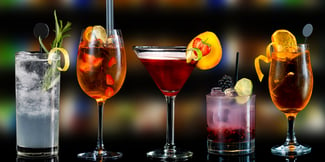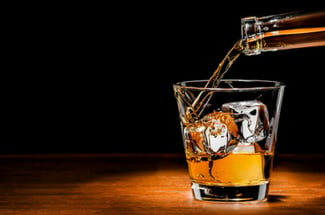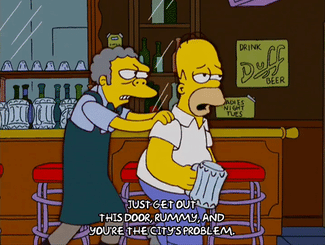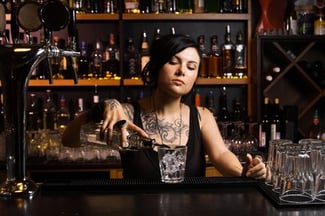There are times when being different and standing out is beneficial. For example, cultivating a unique concept and atmosphere at your bar can distinguish you from your competitors and help generate business. However, there are other times when it’s a smarter tactic to adhere to industry standard best practices. When it comes to establishing pour sizes for your liquor drinks, following the industry standard is usually the best approach.
 Establishing pouring assumptions for your liquor drinks is an important decision to get right. Your portion sizes will impact your pricing, profitability and your ability to pour consistently great-tasting drinks. While there may be a temptation to forge your own path with creative and unique pour sizes, this isn’t the place to distinguish yourself from your competitors. For a variety of reasons that we’ll discuss below, we strongly recommend that you stick to pour sizes that fall within the industry standard range.
Establishing pouring assumptions for your liquor drinks is an important decision to get right. Your portion sizes will impact your pricing, profitability and your ability to pour consistently great-tasting drinks. While there may be a temptation to forge your own path with creative and unique pour sizes, this isn’t the place to distinguish yourself from your competitors. For a variety of reasons that we’ll discuss below, we strongly recommend that you stick to pour sizes that fall within the industry standard range.
What are the Most Common Pour Sizes for Liquor Drinks?
The most common pour sizes for liquor drinks are 1.5 oz. and 1.25 oz. Approximately 80% of bars use a 1.5 oz. pour, making this the most common portion size by far. In some corporate environments and casinos, you may encounter a smaller 1 oz. pour. However, this is generally on the skimpy side and doesn’t fall within the industry standard range.
In addition, there are certain drink variations which may require a slightly different pour size. These include:
- Shots – These are typically smaller than a standard pour and are often 1 oz.
- Rocks – These usually contain .5 oz. more liquor than a standard pour
- Double – As the name implies, these generally contain twice as much liquor as a standard pour
- Martinis – These are usually poured like a double, but this portion size may vary from bar to bar
 High-end bars will sometimes use a 2 oz. pour. While this is slightly larger than industry standard best practices, it fits the upscale clientele at these establishments. Often, the customers that frequent high-end bars are willing to pay a little extra for what they want, which is a strong pour.
High-end bars will sometimes use a 2 oz. pour. While this is slightly larger than industry standard best practices, it fits the upscale clientele at these establishments. Often, the customers that frequent high-end bars are willing to pay a little extra for what they want, which is a strong pour.
One other notable exception to standard pour sizes involves craft cocktails. These drinks often contain 3-5 (or more) ingredients measured in different amounts. In general, craft cocktails will contain a standard liquor plus a combination of liqueurs, bitters, infusions, shrubs and other creative flavors that are added in smaller amounts to create a unique and interesting drink. While the base liquor for a craft cocktail is often poured using a standard pour size, this may change based on the other combination of ingredients being used. For example, if a craft cocktail contains several alcoholic ingredients, the base liquor may be slightly less than a standard pour to avoid serving a drink that is overly boozy.
5 Dangers Associated with Using Non-Standard Pour Sizes
There are several good reasons why you shouldn’t deviate from these standard pour sizes:
- Perceived value isn’t affected – Most customers don’t see you pour their drink and even when they do, they can’t tell exactly how much liquor you poured. When you serve a drink that contains more than a standard portion size, all you’re doing is giving away product without getting any value in return. The customer is enjoying their strong drink, but they don’t necessarily realize they’ve received a generous pour, making it a bit of a wasted effort to give them this extra liquor.
- Reduces the number of drinks purchased – If you have larger portion sizes, some customers will get intoxicated faster and decide not to order that extra drink at the end of the night. This hurts your overall retail sales and therefore reduces your profits.
 Responsible service considerations – If customers are used to drinking 1.5 oz. cocktails and you serve them 2 oz. cocktails, they may not realize they’re drinking more than they normally consume. Over several drinks, this can lead to customers getting significantly more wasted than they would expect, which can lead to issues of responsible service. It’s always best to avoid these issues since they can potentially result in liquor board violations.
Responsible service considerations – If customers are used to drinking 1.5 oz. cocktails and you serve them 2 oz. cocktails, they may not realize they’re drinking more than they normally consume. Over several drinks, this can lead to customers getting significantly more wasted than they would expect, which can lead to issues of responsible service. It’s always best to avoid these issues since they can potentially result in liquor board violations.- Drinks are perceived as being expensive – If you decide to provide a bigger portion size, you need to adjust your prices accordingly in order to maintain a solid profit margin on your drinks. Your customers don’t realize the price is higher due to a larger pour size; instead, they just think they’re getting charged a lot of money for their drink. When comparing the price of your drinks to those at other local bars, many customers may just perceive you as being expensive. They often don’t understand they’re actually receiving value for this extra money.
If you’re going to serve a larger pour size for certain signature drinks such as house margaritas or Bloody Marys, it’s important to communicate this to your customers so they realize they are receiving a strong drink that should cost more and will most likely get them drunk faster.
One situation where you may want to consider the flip side of this argument is with the pour size of your shots. Choosing a smaller pour size can actually be a smart move. If you charge $6 for a 1.5 oz. call drink, you can charge $4 for the same liquor as a 1 oz. shot and achieve the same profit margin (the shot only contains two thirds the amount of alcohol as the cocktail). This tactic will make customers perceive your shots as a value purchase, and you’ll usually increase your check sizes because people are more likely to order shots when they’re cheap. In addition, the risk of overserving decreases because the drink size is smaller. - Simplicity and consistency – We worked with a bar that wanted to change all their tequila drinks to 2 oz. pours to match the portion size of their margaritas. We advised them to just change the pouring assumption for their margaritas while keeping all other tequila drinks at 1.5 oz. If you start changing the pouring assumptions on other tequila drinks, does it only apply to well drinks or also to the high-end tequilas you serve? What about other types of liquor where customers often like a strong pour? Will it be acceptable to give a 2 oz. pour on a rum drink?
These questions can create a level of confusion. If your bartenders have to keep track of different pour sizes for numerous drinks, it will slow them down and cause them to make errors. Neither of these issues is good for your business, and both will cost you money.
In general, it’s best to make sure all your drinks have a consistent pour size unless there is a good reason to make an exception, such as with craft cocktails or signature drinks.
Important Considerations When Establishing Pour Sizes for Your Liquor Drinks
 While we strongly recommend using a standard pour size, the choice of a 1.5 oz. pouring assumption vs. a 1.25 oz. pouring assumption is up to you. Ultimately, it doesn’t really matter which of these pour sizes you choose as long as you discuss your strategy with your management team and arrive at a thoughtful conclusion that will be in the best interest of your business.
While we strongly recommend using a standard pour size, the choice of a 1.5 oz. pouring assumption vs. a 1.25 oz. pouring assumption is up to you. Ultimately, it doesn’t really matter which of these pour sizes you choose as long as you discuss your strategy with your management team and arrive at a thoughtful conclusion that will be in the best interest of your business.
Once you make this decision, you need to communicate it to your staff and stick with it consistently. Making sure your staff knows the correct portion size and pours drinks properly is more important than the specific pouring assumption you choose.
In addition, there are several other important considerations to keep in mind:
- Use the fewest number of variations possible – Balance and consistency is important. If you’re going to vary your standard pour sizes for certain drinks, there should be a good reason to do so. Otherwise, stick to the standard pour size for all other drinks.
- Need to track performance data for the drinks being poured – Arriving at the right pour size for your drinks is a complicated process, and it’s important to track the results of your decision. When we do your inventory audits, we measure against your stated pouring assumptions in order to determine situations where variations from these pour sizes are occurring.
Looking at these variations will inform you as to what is actually being poured by your staff, and you can engage your bartenders in a meaningful conversation regarding why these variations are occurring. If there’s a good reason, you can adjust your standard pouring assumption accordingly. If not, you can make sure your staff starts pouring the proper amount of liquor moving forward. - The same concept can be applied to draft beer and wine – Sticking with a standard 16 oz. pint for draft beers and a 6 oz. wine pour is probably the best approach for the same reasons we’ve discussed above. If you decide to choose a different pour size, such as for very high alcohol content beers, make sure it is communicated clearly to your staff and customers.
If you’d like to learn more about how Bar-i can streamline your operations and help you maximize profits, please contact us today to schedule a free consultation. We serve bars and restaurants nationwide from our offices in Denver, Colorado.


-1.png)